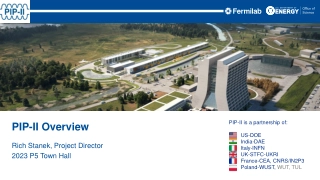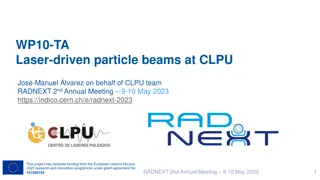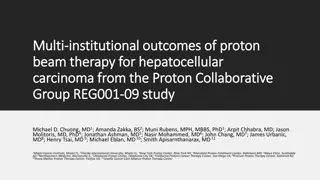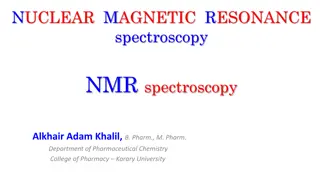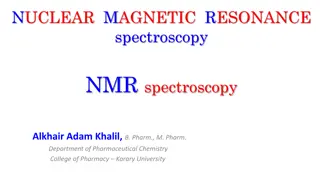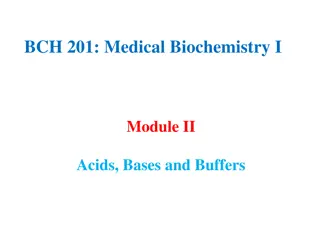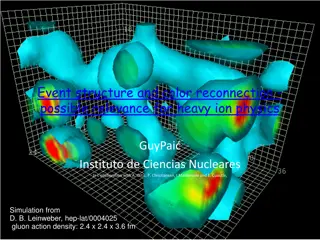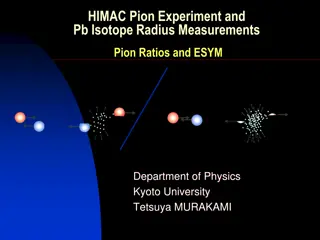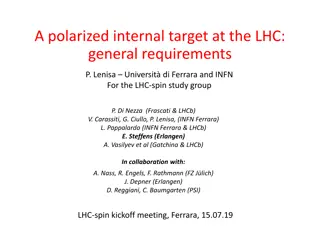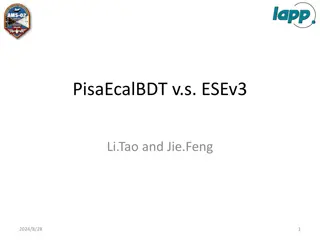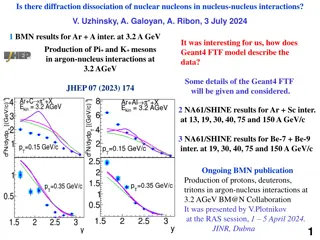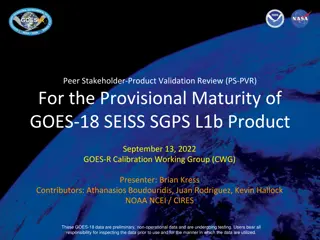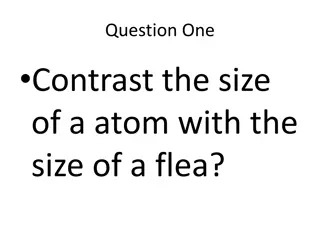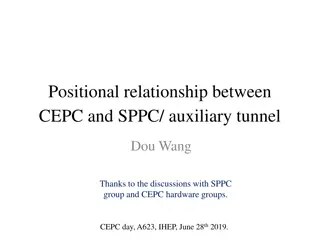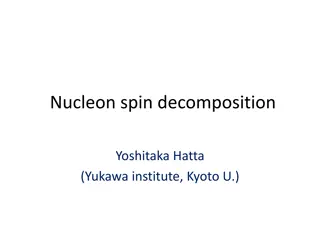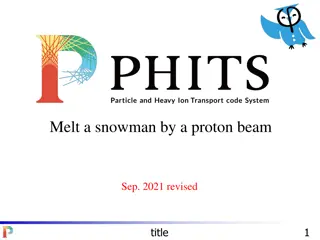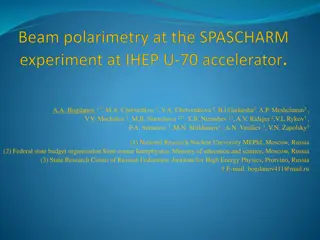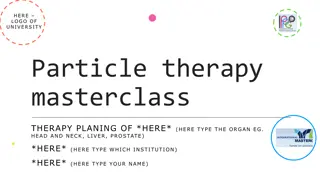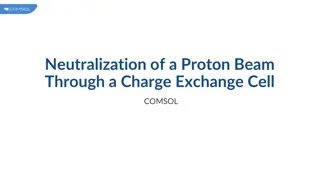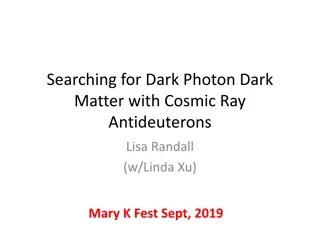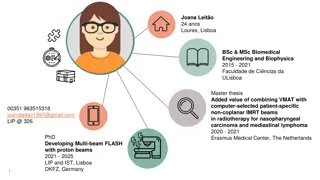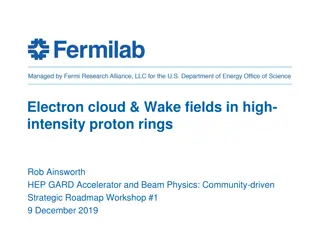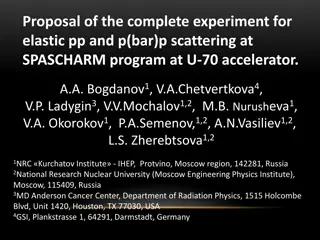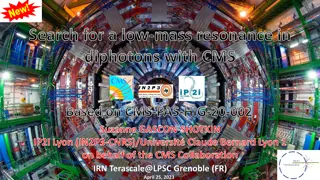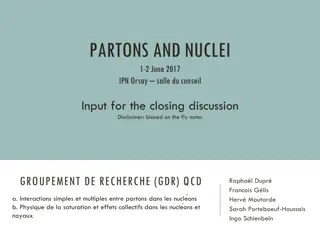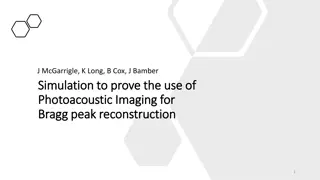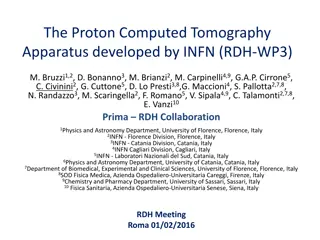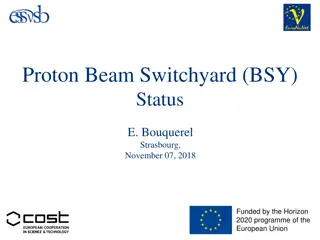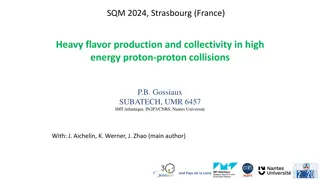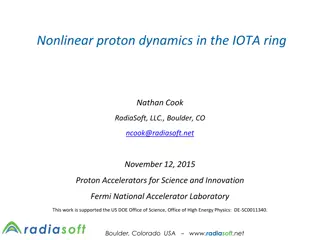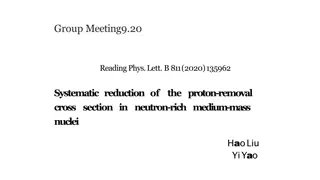FPC & HOM Technology Challenges, FCC
The challenges and technology involved in coupling beam power out of the cavity and coupling RF power into the cavity for the Future Circular Collider (FCC). It also covers the RF layout for the FCC-ee, basic parameters for proton and electron beams, accelerating RF in the LHC, input couplers, and p
0 views • 36 slides
Overview of PIP-II Partnership and Mission
PIP-II is a partnership involving various international institutions such as US-DOE, India-DAE, Italy-INFN, UK-STFC-UKRI, France-CEA, and more. The mission of PIP-II is to upgrade Fermilab's accelerator complex to enable the world's most intense beam of neutrinos and sustain a broad physics program
0 views • 18 slides
Laser-Driven Particle Beams at CLPU: Insights from the RADNEXT 2nd Annual Meeting
Delve into the world of laser-driven particle beams at CLPU as discussed in the RADNEXT 2nd Annual Meeting. Explore topics like high-intensity laser facilities, laser plasma accelerator applications, and the innovative use of Laser VEGA for transnational access. Witness the evolution of laser physic
2 views • 29 slides
Understanding Peptic Ulcer Disease: Causes, Symptoms, and Treatment
Peptic ulcer disease (PUD) involves ulcerations in the duodenal or gastric mucosa caused by factors like Helicobacter pylori infection and NSAID use. Symptoms include abdominal pain and nausea, and treatment often involves H. pylori eradication and proton pump inhibitors to prevent complications lik
1 views • 77 slides
Role and Challenges of PET Imaging in Proton Therapy
PET imaging plays a crucial role in proton therapy by aiding in range verification and monitoring treatment delivery. Proton therapy offers precise tumor targeting but is sensitive to uncertainties, making accurate imaging essential. Positron emitters generated during therapy can be detected using P
1 views • 17 slides
Proton Beam Therapy Outcomes for Hepatocellular Carcinoma: Multi-Institutional Study
This study by the Proton Collaborative Group evaluates the outcomes of proton beam therapy for hepatocellular carcinoma across multiple institutions. Factors such as liver tolerance, baseline function, and prior therapies were considered in the treatment of liver cancer. The study emphasizes the imp
0 views • 22 slides
Introduction to NMR Spectroscopy: A Powerful Tool for Structural Analysis
Nuclear Magnetic Resonance (NMR) spectroscopy is a vital technique in determining the structure of organic molecules. It complements IR and UV spectroscopies by providing a detailed map of the carbon-hydrogen framework. Understanding the physics behind NMR, such as nuclear spin and the effect of mag
6 views • 30 slides
Understanding NMR Spectroscopy for Structure Identification
NMR spectroscopy is a powerful tool in determining the structure of organic compounds. This summary outlines the process of using 1H NMR spectroscopy to identify an unknown compound, detailing steps such as determining different proton types, analyzing integration data, and interpreting splitting pa
3 views • 40 slides
Advances in Ocular Proton Therapy Treatment Planning
Explore the intricate world of ocular proton therapy treatment planning with Dr. Linda Mortimer, PhD. Discover the fundamental elements of an ocular treatment plan, main goals of treatment planning, an overview of dedicated ocular Treatment Planning Systems (TPS), planning workflows, choice of TPS,
1 views • 12 slides
Critical Design Review for Proton Beam Window Port Block and Vessel
The Critical Design Review evaluates the readiness of the Proton Beam Window Port Block and Vessel project at ESS-Bilbao. It involves assessing design completeness, safety considerations, procurement readiness, and project plan alignment with specifications. A committee of experts examines system re
0 views • 8 slides
Understanding Acids, Bases, and Buffers in Medical Biochemistry
Biologically important molecules, such as acids and bases, have significant roles in metabolism. Strong acids like hydrochloric acid ionize completely, while weak acids and bases play crucial regulatory roles. The Bronsted-Lowry theory defines acids as proton donors and bases as proton acceptors. Eq
0 views • 29 slides
Understanding 1H NMR and Proton Environments in Molecules
Exploring the concept of proton environments in molecules using 1H NMR spectroscopy. The presence of different types of hydrogens in a molecule is highlighted, showcasing how protons exist in varied magnetic environments leading to distinct signals in the 1H NMR spectrum. Electron shielding and its
0 views • 36 slides
Event Structure and Color Reconnection in Heavy Ion Physics
Investigating event structures in proton-proton collisions sheds light on potential relevance for heavy ion physics, especially in understanding parton energy loss and hydrodynamic flow dynamics. The study discusses phenomena like color reconnection, underlying events in Pythia, and multiple-parton
1 views • 31 slides
Nuclear Physics Research Highlights: Neutron Stars, Nuclear EOS, and Pb Isotope Studies
Explore cutting-edge research in nuclear physics, including experiments on pion ratios and Pb isotope radius measurements, neutron star observations, neutron density distributions of Pb isotopes, and polarized proton beams at Osaka University. Learn about the analysis of realistic point proton densi
0 views • 26 slides
Study of a Polarized Internal Target at the LHC: General Requirements and Preliminary Results
The LHCb Spectrometer at the Large Hadron Collider is exploring the design of a polarized gas target (PGT) similar to the HERMES target in the VELO alcove. The project aims to improve precision in luminosity measurements for antiproton production in colliding bunches. The new SMOG2 system with addit
0 views • 21 slides
Analysis of ESEv3 in Comparison with PisaEcalBDT - Study and Findings
Our analysis compares PisaEcalBDT with ESEv3 in proton detection. The study evaluates various factors such as side leakage, shower axis direction, and potential corrections using a new function. Uncertainty in antiproton detection is discussed along with current studies' status and future plans for
1 views • 16 slides
Understanding Diffraction Processes and Meson Production in Nuclear Interactions
Exploration of diffraction dissociation of nuclear nucleons in nucleus-nucleus interactions using Geant4 FTF model and NA61/SHINE results for various nucleus combinations. Insights into meson production in argon-nucleus interactions at different energies and the impact of models like DCM/AGT, UrQMD,
0 views • 17 slides
GOES-18 SEISS Solar Galactic Proton Sensor Product Validation Review
GOES-18 SEISS SGPS L1b product is undergoing provisional maturity testing by the GOES-R Calibration Working Group. The review includes evaluation of product quality, supporting instruments, health tests, and path to full validation. Users are responsible for inspecting and utilizing the preliminary
0 views • 39 slides
Exploring Atom Structure and Properties Questions
This series of questions delves into the intriguing world of atoms, covering topics such as atom size comparison, proton count identification, location of metals on the Periodic Table, nucleus charge explanation, atomic number significance, various arrangements of the Periodic Table, subatomic parti
0 views • 12 slides
Cutting-edge Proton EDM Storage Ring Experiment Insights
Detailed overview of the Proton EDM Storage Ring Experiment by William Morse, highlighting challenges in neutron EDM sensitivity, magic momentum phenomenon in electric fields, and advancements in proton EDM experiment sensitivity. Explore the critical parameters related to axion physics, CP-violatio
1 views • 16 slides
Positional Relationship Between CEPC and SPPC for Accelerator Physics
The positional relationship between the Circular Electron-Positron Collider (CEPC) and the Super Proton-Proton Collider (SPPC) involves careful considerations such as bypass tunnels, compatibility for future e-P collision programs, and shielding in the tunnel. Various scenarios are discussed regardi
0 views • 8 slides
Summer Shutdown Planning for Proton.PMG and Accelerator Division - Major Project Listings
Planning for the upcoming summer shutdown at Proton.PMG and Accelerator Division involves prioritizing major projects within a 10-12 week window. Shutdown coordinators gather and prioritize work lists for each machine, ensuring a streamlined process with no last-minute surprises. Detailed tasks incl
0 views • 19 slides
Understanding Nucleon Spin Decomposition and Proton Spin Problem
Explore the complex realm of nucleon spin decomposition and the enigmatic proton spin problem, delving into concepts like orbital angular momentum, quarks and gluons' helicity, and longitudinal double spin asymmetry in polarized deep inelastic scattering. Learn about the spin crisis, gluon polarizat
0 views • 26 slides
Proton Beam Simulation for Melting Snowman in Gundam Analysis
Conducting a proton beam simulation to analyze the feasibility of the beam rifle in Gundam by melting a snowman. The exercise involves setting up geometry, defining parameters, sources, materials, and cells, and calculating energy deposition. Follow the flow chart to determine beam current and power
0 views • 19 slides
Measuring Proton and Antiproton Polarization at U70 Accelerator
Absolute polarimeters are described for the beam channel at U70 Accelerator in Russia, focusing on transporting polarized proton and antiproton beams. Various polarimeters are discussed for measuring proton and antiproton polarization, including diffraction and interference-based techniques. The exp
0 views • 37 slides
Comparison of Photon, Proton, and Carbon Ion Therapy for Liver Cancer
This document elaborates on the comparison of photon, proton, and carbon ion therapy for liver cancer. It includes abstract, phantom CT scan analysis, organ delineation, photon vs. proton therapy comparisons, and proton vs. carbon ion therapy comparisons with corresponding images. Detailed discussio
0 views • 11 slides
Understanding Neutralization of Proton Beam Using Charge Exchange Cell in COMSOL
In various applications, collisions of neutral particle beams with target materials play a crucial role. This process involves neutralizing high-velocity proton beams by passing them through a charge exchange cell filled with neutral gas, such as argon. The cell allows protons to capture electrons f
0 views • 17 slides
Searching for Dark Photon Dark Matter with Cosmic Ray Antideuterons
Exploring the use of cosmic ray antideuterons for dark matter detection is a promising avenue in astrophysics. Antideuteron searches offer a low-background environment, making them ideal for detecting certain types of dark matter particles. Unlike antiproton searches, which face significant backgrou
0 views • 30 slides
Experimental Setup at IP5 for Inelastic Events and Particle Detection
Experimental setup at IP5 involves inelastic telescopes for charged particle detection and vertex reconstruction. The setup includes T1 and T2 telescopes, HF and CASTOR detectors, as well as Roman Pots for measuring elastic and diffractive protons. The TOTEM experiment focuses on proton-proton inter
0 views • 27 slides
Cutting-Edge Research in Proton Beam Therapy by Joana Leitão
Joana Leitão, a Biomedical Engineering and Biophysics graduate, is currently pursuing a Ph.D. focused on developing multi-beam FLASH with proton beams for advanced radiotherapy. Her research involves combining innovative techniques to enhance treatment effectiveness while minimizing damage to surro
0 views • 4 slides
Wake Fields and Electron Cloud in High-Intensity Proton Rings
Investigating wake fields and electron cloud phenomena in high-intensity proton rings is crucial for understanding instabilities and improving accelerator science. This involves experimental studies, analyzing instabilities, controlling wake amplitudes, and protecting future machines operating in st
0 views • 22 slides
Investigation of Spin Observables in Elastic pp and p(bar)p Scattering at SPASCHARM Program
Measurements of spin observables in elastic pp and p(bar)p scattering at 16 GeV will be conducted at the SPASCHARM program using a unique setup with polarized proton and antiproton beams. The experiment aims to extend the energy range for spin studies and compare elastic scattering in pp and p(bar)p
0 views • 24 slides
Search for Low-Mass Resonance in Diphotons with CMS
A search for a standard model-like Higgs boson in the mass range of 70-110 GeV in diphoton final states in proton-proton collisions at √s = 13 TeV using Full LHC Run 2 data was conducted by Suzanne Gascon-Shotkin and the CMS Collaboration. Motivated by previous results and theoretical models, the
0 views • 15 slides
Exploring Parton and Nucleon Interactions in Hadronic Collisions
Discussions at the GDR QCD workshop covered a range of topics from double parton scattering to coherent processes on nuclei, emphasizing the importance of understanding parton interactions in both proton-proton and heavy ion collisions. Theoretical frameworks such as DPS, SPS, GPDs, and TMDs were ex
0 views • 12 slides
Simulation Study of Photoacoustic Imaging for Bragg Peak Reconstruction
This study explores the use of simulation in Photoacoustic Imaging for reconstructing the Bragg peak in proton therapy. It discusses the concept of Photoacoustic Imaging, the generation of acoustic waves from pulsed electromagnetic radiation, and the experimental setups for characterizing proton dos
0 views • 13 slides
Development of Proton Computed Tomography Apparatus by INFN (RDH-WP3)
The Proton Computed Tomography Apparatus, developed by the INFN (RDH-WP3) collaboration, consists of two pCT systems for high-energy tomography. Various tests and analyses have been conducted, with plans for further testing in 2016. The system utilizes Algebraic Reconstruction Techniques and silicon
0 views • 36 slides
Proton Beam Switchyard (BSY) Status Summary - Horizon 2020 Programme
A detailed overview of the Proton Beam Switchyard (BSY) Status funded by the Horizon 2020 programme of the European Union. The aim of BSY is to ensure efficient distribution and focusing of the proton beam onto specific targets. The BSY composition includes various systems like deflecting, focusing,
0 views • 12 slides
Exploring Heavy Flavor Production in High-Energy Collisions
Studying heavy flavor production and collectivity in proton-proton collisions at high energies, this research delves into the effects of collectivity in large and small systems through EPOS4-HQ modeling. It investigates energy loss, coupling with QGP, collectivity, and more, utilizing the EPOS frame
0 views • 46 slides
Nonlinear Proton Dynamics in the IOTA Ring: Advancements in Beam Acceleration
Probing the frontier of proton acceleration, this research delves into nonlinear dynamics within the IOTA ring, showcasing integrable optics and innovative technologies. Collaborations with Fermilab drive advancements in accelerator science, supported by the US DOE. The study explores variational as
0 views • 21 slides
Systematic Reduction of Proton-Removal Cross Section in Neutron-Rich Medium-Mass Nuclei
Single-nucleon knock-out reactions in neutron-rich medium-mass nuclei were studied to investigate the reduction of proton-removal cross section. Short-range correlated nucleon pairs, especially protons, were found to impact the probability of single-proton removal processes. Experimental measurement
0 views • 8 slides

